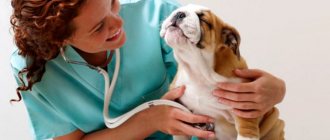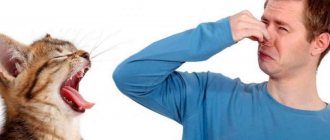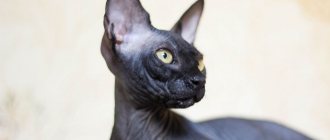Save the article:
Among all cat diseases, coronavirus infection stands out. The complexity of diagnosis, treatment and vaccination makes coronavirus in cats a dangerous contagious disease. An infectious disease, which is not always accompanied by specific symptoms, can be fatal.
What is coronavirus
global $ads_google; //data-ad-slot=”2475549904″ $ads_google = empty($ads_google) ? false : true; ?> if ($ads_google == false) {?>
$ads_google = true; ?> } ?>
Like all representatives of the non-cellular superkingdom of viruses, coronavirus consists of a protein shell and nucleic acid. The genetic component contains single-stranded RNA. The name of the virus was given by its appearance - under a microscope, the coronavirus looks like a ball with many crown-shaped protrusions on the surface.
Coronavirus in cats was first recorded by veterinarians from the United States in 1966. Experts suggest that the virus existed before, but was discovered due to increased attention to cats from nurseries and breeders in the mid-20th century. The geographic spread of the virus has no boundaries. In this case, not only domestic cats can suffer, but also other members of the family (jaguars, lynxes, cheetahs, leopards, manulas).
With a strong immune system, the cat’s body copes with the coronavirus on its own. The owner sometimes does not even notice uncomplicated gastroenteritis in a pet. The danger of the pathogen lies in its high mutation ability. When the structure of RNA changes, the activity of the virus changes. A weak immune system, hypothermia, and poor nutrition contribute to the fact that the mutated coronavirus takes hold in the body and causes serious illness.
Forms
Veterinarians distinguish three forms of coronavirus infection: asymptomatic, mild and severe. The first does not pose a threat to the pet. The cat is not sick, but is a carrier of the virus and can infect other animals. A mild form of the disease is often called dry. It develops slowly and gradually becomes chronic. The severe (or wet) form is much more dangerous, as the virus multiplies rapidly. With this course of the disease, fluid accumulates in the abdominal cavity and effusion peritonitis develops, followed by ascites. In some cases, the dry form turns into a wet form. It happens that against the background of a severe course, remission begins and the wet form turns into dry.
According to statistics, up to 5% of all cases of coronavirus infection in cats occur in severe form.
Types
Doctors distinguish two types of infection. They differ in the strains of the virus. The first is enteric coronavirus (IEC), which causes enteritis. The second is feline infectious peritonitis virus (FIPV), which appears as a result of mutation and is much more pathogenic. IPC attacks intestinal epithelial cells, causing diarrhea. The danger of HIV infection lies in the fact that the virus penetrates immune macrophage cells and destroys them in the process of reproduction. The body produces even more macrophages to fight coronavirus, which only stimulates the increase in the number of the virus.
Diagnosis of coronavirus infection in cats
The ICA diagnostic method (VetExpert express test) is very good to use when selling kittens, during matings, and other cases. Easy to do. The owner can make them himself. This will save the breeder from big troubles. Examine the animal's feces. This method allows you to identify clean and infected ones. This method is extremely important when selling a kitten. It can be performed directly in front of the buyer and this is the great value of this method!
Using the PCR method (polymerase chain reaction). This method shows whether the cat has the virus or not. The disadvantage of this method is that it reacts to a titer of up to 400 and therefore gives a positive result. We submit fresh feces to the laboratory and if the result is negative, we live in peace. A positive result for coronavirus antibodies is not a definitive diagnosis of peritonitis. For more accurate diagnosis there is an ELISA method . Blood is examined.
tab. 1 Quantitative table of coronavirus infection titers.
How dangerous is the virus for a cat?
global $ads_google; //data-ad-slot=”2475549904″ $ads_google = empty($ads_google) ? false : true; ?> if ($ads_google == false) {?>
$ads_google = true; ?> } ?>
During a coronavirus infection, a cat develops pathological processes in those organs that were attacked by viruses. In addition to the gastrointestinal tract, the muscular and nervous systems are affected. A sick cat may have the following negative consequences:
- ataxia (motility disorder);
- paresis or paralysis of the limbs;
- depression;
- convulsions, nystagmus.
In the wet form of the disease, dropsy of the abdominal cavity develops. This functional disorder is accompanied by weight loss and anemia. Every fifth cat has hydrops in the pleural cavity. This entails breathing problems. Later, the clinical picture is complemented by liver damage. Jaundice becomes a harbinger of the imminent death of the animal. The danger of coronavirus in cats is the high probability of death. In some cases, it is not possible to help the animal because the disease develops so rapidly.
Is it dangerous for humans?
Feline coronavirus is a specific structure that is activated only in the cat's body. Humans are resistant to this microbe. Even when mutated forms of coronavirus enter the human body, the immune system copes with foreign particles and inactivates them. Therefore, these pathogens are found only in representatives of the cat family. But a person can be a potential carrier of the virus. Through dirty hands and household items, the pathogen can be transmitted to healthy cats and cause infection in them. Therefore, maintaining hygiene rules in the house and in the yard is a prerequisite for keeping a cat.
Rhinotracheitis in cats
Acute viral disease affecting the upper respiratory tract. Today, there are many causes that can lead to damage to the upper respiratory tract, but this particular virus is recorded in 80% of cases of cat disease. The rhinotracheitis virus is highly contagious. It spreads easily, and is not only an independent disease, but also has the potential to cause complications, such as feline reovirus, chlamydia, pneumonia and others. Particularly severe cases in kittens lead to death, and in pregnant cats up to 6 weeks pregnant, the virus can cause spontaneous abortion.
The virus infects the mucous membranes of the nose and tonsils, after which saliva, tear fluid, and nasal secretions become infectious to other cats. The route of transmission is airborne, and the incubation period of rhinotracheitis in cats ranges from 2 to 20 days. During this period, there are no signs of the disease, so it is very difficult to suspect the presence of pathology.
Symptoms of rhinotracheitis are identical to cat flu. The cat may experience coughing, sneezing, discharge from the nose, or from the eyes. Conjunctivitis, fever, and decreased appetite may develop.
Can a kitten get sick?
Coronavirus infection can affect cats of any breed, age and health status. Veterinarians have not yet established why one organism, under equal conditions, is more resistant than another. At the same time, enough facts have already accumulated in veterinary practice to allow certain conclusions to be drawn about the disease.
There is a category of animals that are most vulnerable to the virus. It includes older cats, albinos, allergy sufferers and kittens. And although during embryonic development the virus is not transmitted to the fetus from a sick mother, a month after birth the kitten can become infected. Symptoms of the disease often appear during the period of weaning the baby from the nursing mother.
Children under 1.5 years of age have a weak immune system and when infected, their body cannot fully fight back the pathogen. The immune status is significantly strengthened when a young cat reaches the two-year mark. That is why kittens require increased attention and care.
The path of the virus in the cat's body
When a virus enters the body, there are 4 possible development paths:
- In 4% of animals, the immune system immediately fights the virus. They are healthy and do not release the virus into the external environment.
- Some are asymptomatic carriers - the cat’s life is not in danger, but he is a lifelong carrier, sheds the virus in his feces and infects others. These animals are healthy but may suffer from chronic diarrhea. This category accounts for 13% of those infected.
- In the body, the virus selects the tonsils and small intestine for reproduction. May not manifest itself for any time. The immune system is struggling. In most cases, the infection goes away. The virus is eliminated from the body, which takes from several weeks to 9 months. On average - 1 month.
- Under the influence of some reasons (it is still not known exactly what) in 10% of infected cats, the virus mutates and becomes pathogenic (dangerous). Most researchers are inclined to believe that the cause of the mutation is related to stress. The virus attacks the immune system. When macrophages and lymphocytes (the main defenders of the immune system) are affected, the virus spreads throughout the body. It is not tied to one organ. Especially a lot accumulates in the liver, spleen and other organs, where there are many blood vessels. With weak immunity, the walls of small vessels are damaged and blood seeps into the cavities, the largest of which is the abdominal cavity. Wet peritonitis occurs. If the immune system fights back, dry peritonitis begins. With any form of infection, immune cells die. The body is not protected and has no chance of survival. Therefore, the disease is considered similar to AIDS and viral leukemia. Ends with the death of the animal.
If a cat is a carrier, then the greatest likelihood of developing FIP occurs before the age of 1 year. In adult pets, even if they have antibodies to enteric coronavirus, the risk is unlikely.
How can an animal become infected?
global $ads_google; //data-ad-slot=”2475549904″ $ads_google = empty($ads_google) ? false : true; ?> if ($ads_google == false) {?>
$ads_google = true; ?> } ?>
The infection is contagious, therefore, among all sources of infection, the virus-carrying animal takes first place. It doesn't matter whether he shows symptoms or not. In this regard, any accumulation of cats on the street, nurseries, shelters, and even accidental contact with a sick individual pose a danger.
Indirect communication through shared care items also plays a role. The source of the coronavirus can be food and water bowls, a tray, and beds. They contain saliva or traces of excrement through which the microbe is transmitted. After a sick cat, the virus lives on objects for another 24 hours, after which it is destroyed. Eating the feces of relatives on the street is also a risk factor for cats, since the coronavirus remains viable in them for much longer - up to several months.
Symptoms of coronavirus infection
Statistics show that 90% of all cats are infected with the virus, but only 10% develop the disease. Lifelong carriage is observed in 13% of pets. With a very mild course of the disease, no external manifestations are noted. For more severe cases, the symptoms of coronavirus in a cat depend on the strain, the age of the pet and its health.
Sign of enteritis
Symptoms of intestinal coronavirus, which occurs in a mild form, are nonspecific and therefore are often similar to signs of other diseases. The main markers are apathy and lethargic behavior of the animal, decreased appetite, thirst, upset stool, temperature fluctuations, mucous discharge from the nose, and lacrimation. The symptomatic picture can be so blurred that it is not always possible to make a correct diagnosis. Viral enteritis is often confused with poisoning or overeating.
Sign of infectious peritonitis
global $ads_google; //data-ad-slot=”2475549904″ $ads_google = empty($ads_google) ? false : true; ?> if ($ads_google == false) {?>
$ads_google = true; ?> } ?>
Coronavirus in cats in severe form can be suspected based on a whole range of serious manifestations. Since the pathogen is able to penetrate different organs, disturbances occur in the functioning of many functional systems. Characteristic signs of infectious peritonitis of the FIP type are:
- frequent vomiting;
- diarrhea, possibly bloody;
- heat;
- fear of light;
- weight loss;
- lethargy;
- yellowness of mucous membranes;
- faded gums;
- yellowness of the ears;
- cough;
- refusal of food;
- bloating.
Signs of coronavirus do not always appear in such a complete set. Their combination is influenced by the general condition of the animal at the onset of the disease. The very first symptoms of coronavirus are intestinal disorders, then they are followed by kidney and liver disorders. At the very last stages, when the nervous system is damaged, the cat develops convulsions, loss of coordination, and paresis.
Symptoms of infection
Animals of any breed can get sick. The first symptom of infection is often diarrhea. It may go away in a week. Sometimes owners do not consider this a reason to contact a veterinarian. They regard diarrhea as a symptom of food poisoning or stress.
Stages of the disease
With the development of a subclinical form of the disease, the animal loses its appetite. Refusal to eat, vomiting and diarrhea are observed. These symptoms may also go away within 1-2 weeks. If the owners do not take action in time, the animal may remain a carrier of the virus. In severe cases, coronavirus enteritis (FECV) or infectious peritonitis (FIPV) develops.
Can viruses mutate in the body? Yes, they can, and this causes the pet’s condition to worsen.
General symptoms
How to identify coronavirus (symptoms of the disease):
- Decreased activity level, drowsiness.
- Refusal to eat or decreased appetite.
- Weight loss, exhaustion.
- Stunted growth in kittens.
- Increase in temperature (norm 38-39C).
- The coat becomes dull, brittle and dry.
- There is an unpleasant odor from the mouth.
- Palpation of the abdomen causes pain (the cat meows and tries to escape).
- Plaque may appear on the tongue and eyelids.
Enteritis and gastroenteritis
Coronavirus gastroenteritis in cats is an inflammation of the stomach and small intestine caused by a virus. A symptom of the disease is diarrhea, which may contain blood and undigested food fragments.
Enteritis is often accompanied by vomiting and bloating. Symptoms characteristic of a cold are less common: nasal discharge, sneezing, coughing. Due to anemia, the mucous membrane of the palate turns pale.
Infectious peritonitis
The main symptom of peritonitis is an increase in abdominal volume. Due to the accumulation of fluid in the abdominal cavity, it becomes rounded. Heart failure and shortness of breath occur, which can progress to pleurisy.
Sometimes dry peritonitis develops, which is accompanied by organ granulomatosis. When an animal's liver is damaged, yellowing of the mucous membranes is observed. If the kidneys fail, urination is impaired. Atony, convulsions, and paralysis of the limbs develop.
Video from a veterinarian about peritonitis
How can an animal become infected?
The owner should know exactly how coronavirus is transmitted in cats in order to protect the pet from infection. The cat family is characterized by 6 modes of transmission of infection (FECV strain):
- Contact with urine or feces.
- Using one bowl.
- Contact with nasal discharge.
- Contact with secretions from sneezing and coughing.
- Transplacental transfer.
- Infection of kittens through milk.
The main route of infection is oral-fecal. Contact for infection can be not only direct. The virus is sometimes transmitted through humans, for example, if the owner does not wash his hands after cleaning the litter box. The FIPV strain is transmitted only through blood.
Video about transmission of the virus to an animal
The incubation period of the virus is 2-3 weeks. A recovered individual sometimes remains infectious for 2-3 months after the symptoms disappear.
All premises where a horde of cats are located are at risk: basements, shelters, dysfunctional apartments of pensioners. If you take a pet from poor conditions, you need to be tested for infection.
Diagnostic tests
One test is not enough to make an accurate diagnosis. Tests for coronavirus are carried out in a complex:
- Stool tests: PCR (polymerase chain reaction), ICA (immunochromatographic analysis).
- Blood tests for antibodies: ICA, ELISA (enzyme-linked immunosorbent assay).
- General clinical analysis and blood biochemistry.
- PCR diagnostics of blood serum.
- Antibody titer. (400-800 suspicion, 800-1600 carrier, from 1600 acute form).
- Testing the sensitivity of microflora to antibiotics.
- Biopsy and tissue histology (complex tests that are not carried out in every clinic).
Any virus test sometimes gives a false positive result. To avoid mistakes when making a diagnosis, you should retake the test 2-3 times. You can do this in several laboratories so as not to doubt the results.
After treatment, coronavirus tests are performed to check the effectiveness of the therapy. Cure is indicated by 3 negative results obtained in a row.
An inexperienced veterinarian may confuse infectious peritonitis with ascites. If the doctor diagnoses “ascites” after examining the animal, insist on a clinical diagnosis. You need to act quickly and not skimp on tests. Otherwise, you may lose your pet.
Can a kitten get sick?
Kittens under 1 year of age and older cats are at risk. In kittens, immunity has not yet been formed, and in old cats, the immune system is weakened. Old age begins after 7-8 years. If your pet is at risk, be more attentive to preventive measures.
Treatment of kittens
When treating kittens, the same schemes are used as for adults. The difference lies in the doses of drugs, which depends on weight. It is recommended that kittens be treated in a hospital because they quickly develop dehydration and other complications.
Diagnosis and tests for coronavirus
It is very difficult to determine for sure that a cat has an intestinal infection. The clinical picture is similar to other diseases (toxoplasmosis, viral leukemia, immunodeficiency). In most cases, an indicative symptom of coronavirus in a cat at a late stage is an enlarged abdomen. Bloating occurs due to the accumulation of fluid in the abdominal and pleural cavities. But even in this case, an error is possible. Diagnostics helps determine the cause of a cat’s painful condition.
The veterinarian first writes out a referral for immunochromatographic analysis (ICA) and polymer chain reaction (PCR) of blood and feces. The material for these studies is stool, rectal swab, and blood. PCR helps determine the presence of viral RNA. But this test often gives false positive or false negative results. Therefore, it is repeated three times for 14 days. If the answer is negative, then we can say with confidence that there is no microflora containing coronavirus in the cat’s body.
In case of a positive result, it is advisable to conduct additional tests to clarify the diagnosis. For this purpose, a serological, biochemical blood test and a titer test for blood protein fractions are prescribed. The latter allows you to determine the concentration of antibodies, and, therefore, the severity of the disease. Serological testing can also produce erroneous results, so it is repeated several times. If laboratory tests give a clear indication of peritonitis, a puncture from the abdominal cavity is taken from the sick animal. Studying ascites fluid allows you to clarify the diagnosis, stage of the disease and develop a treatment regimen.
Virus carriage does not mean the presence of a mutated pathogen that causes infectious peritonitis.
What to do if the test is positive
The virus can be detected in both sick and healthy cats.
Priority measures:
- Don't panic. It is not at all necessary that FIP will develop.
- Isolate other domestic cats. This is not always possible. But the owner can provide each pet with a separate tray, provide several scoops for cleaning trays, and individual bowls. The feeding area should be as far away from the toilet room as possible.
- Refuse mating, exhibitions, etc.
- Review your pet's diet. Switch to dietary nutrition.
- It is imperative to eliminate stress for 1-2 months and, if possible, not carry out activities that can cause stress - haircuts, scheduled sterilization or castration operations.
Treatment of coronavirus
After the discovery of intestinal coronavirus, scientists have not yet developed a single effective treatment regimen and have not invented an anti-coronavirus drug that would help fight the infection. It is not possible to treat only with antibiotics, the action of which is primarily aimed at bacteria. Only when a bacterial infection occurs against the background of a viral infection are antibiotic drugs included in the prescription list. Treatment of coronavirus is based on eliminating symptoms, correcting the immune system, and alleviating the condition of the sick cat.
General therapy
A sick cat is prescribed antiviral medications, corticosteroids to relieve inflammation, and antibiotics to extinguish bacterial flora. In parallel, therapy includes immunomodulators and vitamins that stimulate the natural defense mechanisms in the cat’s body. The choice of these drugs should only be made by a veterinarian, since many strong immunomodulators intended for humans are contraindicated in severe cases of FIP in cats.
To relieve intoxication and facilitate the functioning of the liver and intestines, the veterinarian prescribes enterosorbents. To relieve spasms, use no-shpu or papaverine in injections. If one of the symptoms is vomiting, then Metoclopramide, Prochlorpromazine or any other antiemetic drug is prescribed to eliminate it.
Enteritis therapy
The mild form of the disease is more difficult to diagnose, but much easier to treat. After determining the cause of the disease, the pet’s amount of food is limited. On the first day, water fasting is indicated for the cat. In case of severe dehydration, droppers are given with a solution of vitamins and glucose. If diarrhea is pronounced, then the pet is prescribed medications with a fixing effect.
On the second day, the furry patient is switched to oatmeal without milk, which plays not only a nutritional, but also an adsorptive role. Starting from the fourth day, a small amount of lean minced meat is introduced into the menu.
If, during the treatment of coronavirus, the cat’s temperature does not subside and the symptoms of intestinal distress do not disappear, veterinarians supplement therapy with antibiotics to exclude complications. The recovery course is completed by taking vitamin complexes, probiotics and prebiotics, which restore normal intestinal microflora.
Treatment of peritonitis
global $ads_google; //data-ad-slot=”2475549904″ $ads_google = empty($ads_google) ? false : true; ?> if ($ads_google == false) {?>
$ads_google = true; ?> } ?>
Although the percentage of severe forms of coronavirus infection is not very high compared to mild ones, treating it is problematic. Veterinarians have developed a general set of measures that can support the body. The first block of procedures is aimed at relieving pain. For this purpose, an ice compress is used on the abdominal area and painkillers.
Just as in the case of enteritis, the cat is prescribed antiviral, antibiotic, corticosteroid, diuretic, and vitamin preparations. In severe cases of the disease, some medications are administered as subcutaneous injections. A little later, immunotherapy using recombinant drugs (Roncoleukin, Betaleukin) is added.
To make breathing easier for the animal, a puncture of the abdominal cavity is performed to remove excess exudate. However, in most cases this measure is temporary, as the fluid accumulates again. Enteral lavage with saline solution is used to cleanse the gastrointestinal tract.
Treatment of the wet form of coronavirus infection is aimed at preventing complications.
Features of the disease
As usual, most often coronavirus in cats manifests itself at a very young age, that is, small kittens are primarily susceptible to it. Of course, the fatal outcome in this case is also accelerated by the fact that dehydration of a small body can occur in a matter of hours. The virus attacks the lining of the small intestine, resulting in diarrhea and diarrhea. However, the first sign is vomiting, and only then it turns into diarrhea, which lasts 2-4 days. After this, either the death of the animal or recovery occurs. However, even after complete recovery, it remains a carrier of the virus, which means it is potentially dangerous to its relatives.
Prevention and vaccination of coronavirus
The best prevention option would be a coronavirus vaccine. Work on its development has been ongoing since the early 90s of the 20th century. American scientists have obtained the Primucell vaccine, which is administered intranasally into the cat’s body. Despite the high cost of the vaccine, its effectiveness is not high enough. In addition, the coronavirus vaccine is rarely used in Russia.
Since intestinal coronavirus is most often found in large cat populations, preventive measures include mass serological surveys of shelters and nurseries. Carriers and already sick cats and kittens are isolated. This measure, in parallel with antiviral prophylaxis, makes it possible to keep under control a dangerous disease spreading among purebred animals.
To avoid treating cats in the future, you should keep the premises clean. It is recommended to regularly treat cat personal hygiene items with disinfectants. Coronavirus dies at high temperatures, in ammonia, 3% sodium hypochlorite solution.
To maintain a cat’s immunity against coronavirus, it is necessary to organize a nutritious diet, monitor the deworming schedule, neutralize stressful situations, and create physical activity according to age. Such prevention can serve as a good alternative to vaccination.
global $ads_google; //data-ad-slot=”2475549904″ $ads_google = empty($ads_google) ? false : true; ?> if ($ads_google == false) {?> $ads_google = true; ?> } ?>
How is coronavirus transmitted in cats?
At the initial stage of infection, the virus is released in saliva. Animals become infected by eating from the same bowl or by licking each other. But the main route is through the feces of sick cats and carriers. In 1 g. stool contains billions of viral particles. Animals become infected through airborne droplets, ingesting or inhaling the virus. The infection can be transmitted to cats through human clothing and shoes soiled with contaminated feces.
Coronavirus infection is a highly contagious disease. A small particle of litter from an infected cat's litter box is enough to infect others.
In kittens, the infection appears more often at the age of 5-7 weeks, when there are few protective antibodies in the mother’s milk, and their immunity has not yet strengthened. Infection of the fetus when the infectious agent penetrates the placenta is isolated cases. Also, there are no viral particles in the female’s milk.
The infection is most common in shelters and nurseries, where animals are kept crowded, becoming infected from each other again and again. Cats living alone or in small groups rarely develop infectious peritonitis.











